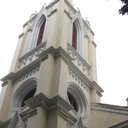Preparation and characterization of an extracellular polysaccharide produced by the deep-sea fungus Penicillium griseofulvum.
Mots clés
Abstrait
The deep-sea fungus Penicillium griseofulvum produces an extracellular polysaccharide, Ps1-1, when grown in potato dextrose-agar medium. Ps1-1 was isolated from the fermented broth using ethanol precipitation, anion-exchange and size-exclusion chromatography. Ps1-1 is a galactomannan with a molecular weight of about 20 kDa, and a molar ratio of mannose and glucose of 1.1:1.0. On the basis of one- and two-dimensional nuclear magnetic resonance (1D and 2D NMR) and mass spectroscopic analyses, Ps1-1 is composed of a long chain of galactofuranan and a mannose core. The galactofuranan chain consists of (1→5)-linked β-galactofuranose, with additional branches at C-6 consisting of (1→)-linked β-galactofuranose residues and phosphate esters. The mannan core is composed of (1→6)-linked α-mannopyranose substituted at C-2 by (1→)-linked α-mannopyranose residues, disaccharide and trisaccharide units of (1→2)-linked α-mannopyranose. The investigation demonstrated that Ps1-1 was a galactofuranose-containing galactomannan differing from previously described extracellular polysaccharides.



